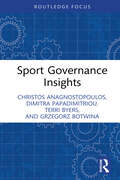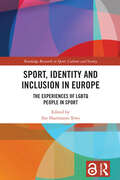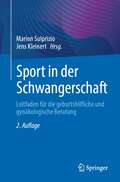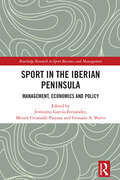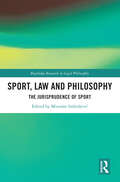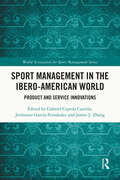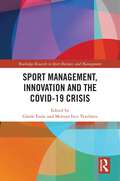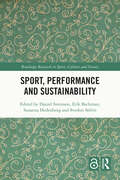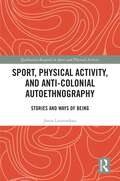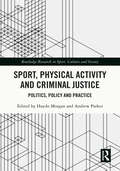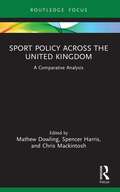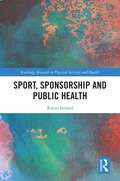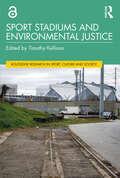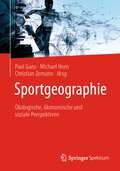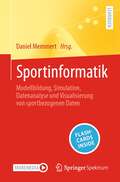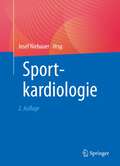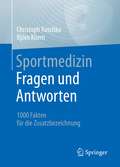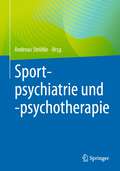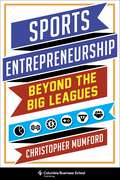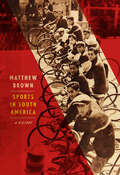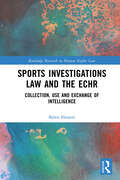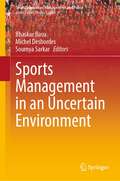- Table View
- List View
Sport Governance Insights (Sport Business Insights)
by Christos Anagnostopoulos Dimitra Papadimitriou Terri Byers Grzegorz BotwinaThis book introduces the fundamentals of sport governance, assuming no prior knowledge on the part of the reader. It explains to students and practitioners alike why governance matters and how it can be better practiced in sport organizations. Introducing key concepts and the micro-processes of implementation, the book explains what governance is and why it has become increasingly important. It explains what sport boards do, and how they should function for sport organizations to be effective, and it provides practical tools to help ensure good governance. Full of insights from cutting-edge research and real-world cases, this is essential reading for any student or practicing sport manager, administrator, or policy-maker who needs a concise introduction to this important topic.
Sport, Identity and Inclusion in Europe: The Experiences of LGBTQ People in Sport (Routledge Research in Sport, Culture and Society)
by Ilse Hartmann-TewsThis book explores and critically assesses the challenges and experiences of LGBTQ people within sport in Europe. It presents cutting-edge research data and insights from across the continent, with a focus on sport policy, sport systems, and issues around anti-discrimination and inclusion. The book introduces the theoretical and methodological foundations of research into LGBTQ people in sport and then presents in-depth comparative surveys of systems and experiences in Austria, Belgium, France, Germany, Hungary, Italy, the UK, and Spain. A final section considers the effectiveness of policy in this area and motives for participation, and looks ahead at future directions in research, policy, and practice. Tracing the frontiers of our understanding of the experiences of LGBTQ people in contemporary Europe, this is fascinating reading for anybody with an interest in the sociology of sport, sport policy, LGBTQI studies, gender and sexuality studies, or cultural studies.
Sport in der Schwangerschaft: Leitfaden für die geburtshilfliche und gynäkologische Beratung
by Marion Sulprizio Jens KleinertDieses Buch richtet sich an Alle, die sich mit der Beratung und Betreuung zum Thema „Sport in und nach der Schwangerschaft“ differenzierter auseinander setzen wollen. Hierzu bietet es ein fundiertes Wissen, um Schwangere optimal zu betreuen, zu beraten oder zu begleiten. Das Buch gibt einen Überblick über die Grundlagen von sportbezogener Beratung in der Schwangerschaft und beschreibt die Auswirkungen von Bewegung auf den mütterlichen und fetalen Organismus sowie die Effekte auf Psyche und Wohlbefinden. Weiterhin gibt der Leitfaden konkrete Trainingsempfehlungen auf Basis der aktuellen Studienlage, informiert zu Kontraindikationen und geht auf spezielle Themen wie beispielsweise Risikoschwangerschaft und Beckenboden ein.
Sport in the Iberian Peninsula: Management, Economics and Policy (Routledge Research in Sport Business and Management)
by Jerónimo García-Fernández Moisés Grimaldi-Puyana Gonzalo A. BravoThis is the first book in English to offer an overview of the development of the sport industry in Spain and Portugal, examining the social, economic, cultural, and political impact sport has had in this region and on world sport more broadly. Drawing on sources in Spanish and Portuguese, the book presents important new perspectives and empirical material not previously available to English-speaking audiences. With a strong focus on management, development, economics, governance and law, set in a broader historical and socio-cultural context, the book explains the unique characteristics of the sport industry in the Iberian Peninsula. It takes a deep dive into Spanish and Portuguese football - in many ways the centre of gravity of Iberian sport – and into sport tourism, a hugely significant component of the broader economy of the region. The book also considers important emerging themes in Iberian sport, from the development of women’s sport to the global profile of Cristiano Ronaldo and Rafael Nadal, and considers the wider influence of Iberian sport across the wider Hispanic diaspora. This is fascinating and illuminating reading for anybody with an interest in sport business and management, global sporting cultures, international business, or Hispanic or Latin American studies.
Sport, Law and Philosophy: The Jurisprudence of Sport (Routledge Research in Legal Philosophy)
by Miroslav ImbriševićSport, Law and Philosophy: The Jurisprudence of Sport discusses the intersection of law and sport and highlights its usefulness to both legal scholars and philosophers of sport. There is a general recognition that law and sports bear strong similarities. Both can be understood as systems of rules, with a judge/referee who has the power to adjudicate and to issue punishments/penalties. Divided into two parts, this volume presents an exploration of central philosophical issues arising from the intersections of law and sport and makes reference to current events and controversies. Experts from across the globe discuss a range of issues such as sports as legal systems, the game as a social contract, the role of the referee, including VAR, rule breaking, equality in women’s sport, justice on the sports field and in the court room, and issues surrounding the application of law to sports. The book will be a valuable resource to Undergraduates, Postgraduates and for those working in the areas of legal philosophy, sports law, and philosophy of sport.
Sport Management in the Ibero-American World: Product and Service Innovations (World Association for Sport Management Series)
by Gabriel Cepeda Carrión Jerónimo García-Fernández James J. ZhangThis book explores innovation in technology, products, and services in sport management in the Ibero-American region, one of the most rapidly developing regions in world sport. This timely volume captures a sense of the potential impact and opportunities presented in the region for international sport businesses and sporting organisations. The book presents cutting-edge research into topics as diverse as digitization in the Chilean sport industry; responses to COVID-19 by sports clubs in the region; consumer behavior in the Portuguese fitness industry; multiplatform content distribution in Brazilian basketball, and the strategy behind the growth and development of the Valencia marathon in Spain. It is full of insight, data, and examples of best practice in innovation. This is fascinating reading for any student, researcher, or practitioner working in sport management, sport business, sport governance, international business and management, or Ibero-American studies.
Sport Management, Innovation and the COVID-19 Crisis (Routledge Research in Sport Business and Management)
by Meltem Ince Yenilmez Gözde ErsözThis book looks at how sport and sports organisations have had to innovate during the COVID-19 pandemic. Against a backdrop of lockdowns, empty stadia and a fast-moving public health crisis, the book presents fascinating case studies of innovation and crisis management in sport, with valuable lessons to be learned for preparedness and resilience in future crises. The book explores how managerial processes have evolved during the pandemic in areas as diverse as sports communication, youth sport, sports events, esports, sports tourism, and physical activity, in both professional and community settings. It considers the fundamental importance of technology as a tool of innovation, and considers how different stakeholder groups, from governing bodies to athletes to fans, have developed new pathways of engagement and what that might mean for the future development of the sport industry. This book is fascinating reading for any student, researcher, practitioner or policy maker looking to better understand this profound moment in the history of sport and society, and to anybody with an interest in key themes in sport business and management, such as innovation, crisis management or consumer behaviour.
Sport, Performance and Sustainability (Routledge Research in Sport, Culture and Society)
by Daniel Svensson Erik Backman Susanna Hedenborg Sverker SörlinThis book examines the logic of ‘faster, higher, and stronger’ and the technoscientific revolution that has driven tremendous growth in the sports economy and in sport performance over the last 100 years. It asks whether this logic needs revisiting in the light of the climate crisis and sport’s environmental responsibilities. Drawing on multi-disciplinary work in sport history, sport pedagogy, sport philosophy, sport science, and environmental history, the book considers not only how sportification may have contributed to the growing environmental impact of sport but also whether it might be used as a tool of positive social change. It reflects on the ways that sport sets performance limits for other ethical reasons, such as doping controls, and asks whether sport could or should set limits for environmental reasons too. Sport, Performance and Sustainability touches on key themes in sport studies, including digitisation, activism, social media, empowerment, youth sport, and physical education. This is fascinating reading for anybody with an interest in sport, the environment, development, sociology, or culture. Daniel Svensson is an Associate Senior Lecturer in Sport Management at the Department of Sport Sciences, Malmö University, Sweden. He has written several book chapters and articles about the relationship between sport, science, technology, and the environment. Erik Backman is an Associate Professor and Senior Lecturer in Pedagogy and Sport Sciences at the Department of Sport Sciences, School of Health and Welfare, Dalarna University, Sweden, and Associate Professor at the Department of Primary and Secondary Teacher Education, Faculty of Education and International Studies, Oslo Metropolitan University, Norway. His main research interest is in outdoor education, physical education, and sport pedagogy. Susanna Hedenborg is a Full Professor in Sport Sciences at Malmö University, Sweden, and the President of the Swedish Research Council for Sport Science. Hedenborg has a background in social and economic history and her sport research has focused on gender issues, children and youth sport, and equestrian sports. Sverker Sörlin is a Professor of Environmental History in the Division of History of Science, Technology and Environment, KTH Royal Institute of Technology, Sweden, and a co-founder of the KTH Environmental Humanities Laboratory. His research is on the role of knowledge in environmentally informed modern societies and in research and innovation policies. Current research interests include the history of environmental climate governance.
Sport, Physical Activity, and Anti-Colonial Autoethnography: Stories and Ways of Being (Qualitative Research in Sport and Physical Activity)
by Jason LaurendeauThis book offers a brief history of how autoethnography has been employed in studies of sport and physical (in)activity to date and makes an explicit call for anti-colonial approaches - challenging scholars of physical culture to interrogate and write against the colonial assumptions at work in so many physical cultural and academic spaces. It presents examples of autoethnographic work that interrogate physical cultural practices as both produced by, and generative of, settler colonial logics and structures, including research into outdoor recreation, youth sport experiences, and sport spectatorship. It situates this work in the context of key paradigmatic issues in social scientific research, including ontology, epistemology, axiology, ethics and praxis, and looks ahead at the shape that social relations might take beyond settler-colonialism. Drawing on cutting-edge research and presenting innovative theoretical perspectives, this book is fascinating reading for anybody with an interest in physical cultural studies, sport studies, outdoor studies, sociology, cultural studies, or qualitative research methods in the social sciences.
Sport, Physical Activity and Criminal Justice: Politics, Policy and Practice (Routledge Research in Sport, Culture and Society)
by Haydn Morgan Andrew ParkerThis book explores the various ways in which participation in sport and physical activity might contribute to effective solutions within criminal justice systems. Focusing on a range of different sporting and physical activities across an array of social contexts involving both adult and youth populations, the book offers insight into the way in which sport and physical activity is interpreted by participants and practitioners, and how these interpretations relate to broader policy objectives within and across justice systems. It focuses on a series of key issues, including how sport policy (national and international) has developed in recent years in this area; how and to what extent such policy developments have impacted organisations and interventions (both custodial and non-custodial) across sport and criminal justice systems and sectors; and how participant cohorts (such as disadvantaged and/or ‘at-risk’ young people) have experienced these changes. With shifting debates around criminal justice and the need for policy and practical solutions to extend beyond tougher and longer sentencing, this book is important reading for students, researchers, and practitioners working in sport pedagogy, sport-for-development, sport and leisure management, sport coaching, physical education, criminology, youth work, youth studies, social work, and health studies.
Sport Policy Across the United Kingdom: A Comparative Analysis (Routledge Focus on Sport, Culture and Society)
by Mathew Dowling Spencer Harris Chris MackintoshThis book provides a comparative analysis of sport and physical activity policies, processes, and practices across the home nations (England, Scotland, Wales, and Northern Ireland) of the United Kingdom. Drawing upon in-depth analysis by internationally recognised experts within the sport policy and management field, and applying a novel analytical framework, this book offers the first comprehensive intra-country comparison of the most significant features of the sporting infrastructure across the home nations. With chapters focusing on each of the four nations in detail, followed by a comparative chapter that identifies themes regarding the evolution of sport policy across the UK, the book examines the differences and similarities across elite, community, and school sport policy. It provides an important insight into how sport policy interacts with national and devolved political structures and with sociocultural factors to drive both elite sporting success and community sport development. This book is essential reading for any student, researcher, policymaker or sport practitioner with an interest in sport policy, sport development, sport management, public policy, or politics.
Sport, Sponsorship and Public Health (Routledge Research in Physical Activity and Health)
by Robin IrelandThis book examines the development of sport sponsorship and its impact on global public health. It argues that sport governing bodies should not continue to treat fans solely as consumers, and that a more ethical approach should be taken to sport sponsorship. Drawing on research from sport studies, marketing and public health, the book presents a brief history of advertising and marketing in sport, including the importance of tobacco in the development of sport sponsorship, before exploring key aspects of the contemporary relationship between sport and corporate sponsors, including mega-events, digital technologies and brand engagement. It offers an in-depth case study of sponsorship in the English Premier League – one of the world’s most successful sporting properties – before considering how sport might be better regulated, now and in the future, to better protect the interests of fans and other stakeholders from a health perspective. The book features a number of insightful images showcasing sport sponsorship in connection with tobacco, mega-events, alcohol, junk food and drink, and gambling over the years. Addressing a topical and hugely important issue, this is important reading for students, researchers, practitioners and policy makers with an interest in sport business and management, the ethics of sport, physical activity and health, event studies, marketing or public health.
Sport Stadiums and Environmental Justice (Routledge Research in Sport, Culture and Society)
by Timothy KellisonThis book explores the local environmental impact of sports stadiums, and how that impact can disproportionately affect communities of color. Offering a series of review articles and global case studies, it illustrates what happens when sport organizations and other public and private stakeholders fail to factor environmental justice into their planning and operations processes. It opens with an historical account of environmental justice research and of research into sport and the natural environment. It then offers a series of case studies from around the world, including the United States, Canada, Kenya, South Africa, and Taiwan. These case studies are organized around key elements of environmental justice such as water and air pollution, displacement and gentrification, soil contamination, and transportation accessibility. They illustrate how major sports stadiums have contributed positively or negatively (or both) to the environmental health of the compact neighborhoods that surround them, to citizens’ quality of life, and in particular to communities that have historically been subjected to unjust and inequitable environmental policy. Placing the issue of environmental justice front and center leads to a more complete understanding of the relationship between stadiums, the natural environment, and urban communities. Presenting new research with important implications for practice, this book is vital reading for anybody working in sport management, venue management, mega-event planning, environmental studies, sociology, geography, and urban and regional planning.
Sportgeographie: Ökologische, ökonomische und soziale Perspektiven
by Paul Gans Michael Horn Christian ZemannVom Lauf im Park bis zu Olympischen Spielen – Sport hat viele Facetten und die Wirkungen auf Umwelt, Wirtschaft und Gesellschaft sind immens. Sport braucht dabei immer Räume: Stadien, Sportplätze und Schwimmhallen, Berge und Wälder, Parks, Straßen oder Industriebrachen. Individualisierung und Lifestyle differenzieren den Sport mit neuen Anforderungen an die Nutzung des Raumes.Ökologisch wirkt Sport im Spannungsfeld Natursport und Naturschutz oder wenn Großveranstaltungen neue Infrastrukturen benötigen und zehntausende Menschen anziehen. Ökonomische und soziale Effekte können erheblich sein, sind oft aber nur von kurzer Dauer. Dies führt zur Frage der Nachhaltigkeit. Was bewirkt Skibetrieb in Zeiten des Klimawandels? Was kosten sportliche Großereignisse, welche Effekte entstehen auf Einkommen und Arbeitsmarkt? Was trägt Sport zu Integration, Empowerment, Image und Identität bei? Und wie können Kommunen und Regionen dies in die Planung von Sportstätten und in die Sport- und Stadtentwicklung integrieren? Das erste Buch, das Sport und Geographie aus Perspektiven der Nachhaltigkeit umfassend vereint, behandelt Wirkungen und deren Ursachen systematisch, bietet Definitionen wichtiger Konzepte und bezieht Breitensport, Trendsport und Natursport ebenso ein wie Spitzensport. Basierend auf langjähriger Forschung beleuchten die Autorinnen und Autoren aus unterschiedlichen Disziplinen die Entwicklungen sportlicher Aktivitäten und ihre Raumansprüche. Als Lehrbuch bietet dieser Band einen linearen Einstieg und Überblick. Im Sinne eines Sammelbands kann jedes Kapitel für sich gelesen werden. Die Erkenntnisse sind gleichermaßen nützlich für Forschende und Studierende der Fächer Geographie, Sportwissenschaft, Sozialwissenschaft und Wirtschaftswissenschaften sowie der Raum-, Regional- und Stadtplanung.
Sportinformatik: Modellbildung, Simulation, Datenanalyse und Visualisierung von sportbezogenen Daten
by Daniel MemmertIn den letzten Jahren ist die Sportinformatik extrem gewachsen, vor allem weil immer mehr und neuere Daten verfügbar wurden. Sportinformatische Tools – sei es im Training zur Gegnervorbereitung, im Wettkampf oder in der Wissenschaft – sind im Sport heute auf unterschiedlichen Expertise-Ebenen unverzichtbar. Durch den Einsatz in den vier großen Anwendungsfeldern Vereine und Verbände, Wirtschaft, Wissenschaft sowie Medien ist ein völlig neuer Markt entstanden, der innerhalb der universitären Forschungs- und Lehraktivitäten zunehmend an Bedeutung gewinnt.Dieses Lehrbuch möchte der mittlerweile breiten Vielfalt der Sportinformatik gerecht werden, indem mehr als 30 Autorinnen und Autoren aus ihrem Spezialgebiet berichten und neueste Erkenntnisse prägnant zusammenfassen. Das Werk gliedert sich in vier Hauptabschnitte: Datensätze, Modellbildung, Simulation sowie Datenanalyse. Neben Hintergründen zu Programmiersprachen und zur Visualisierung wird es von der Historie und einem Ausblick eingerahmt. Studierende mit Bezug zur Sportwissenschaft erhalten einen umfassenden Einblick in die Sportinformatik, unterstützt durch ein didaktisch ausgefeiltes Konzept, das eine einfache Vermittlung der Lerninhalte ermöglicht. Zahlreiche digitale Übungsfragen untermauern den Lerneffekt und gewährleisten eine optimale Prüfungsvorbereitung. Für Fortgeschrittene bietet die vertiefende Diskussion von Zeitreihen Data Mining, künstlichen neuronalen Netzwerken, Convolution Kernel, Transfer Learning und Random Forests einen zusätzlichen Mehrwert.
Sportkardiologie
by Josef NiebauerIn der Sportmedizin und Kardiologie gewinnt die Sportkardiologie zunehmend an Bedeutung mit den Bestrebungen eine Subspezialisierung zu etablieren. Derzeit ist sie in Lehre und Klinik jedoch unterrepräsentiert und Sportmedizinern und Kardiologen, die Sportler betreuen, stellen sich häufig sportkardiologische Fragen, auf die sie bisher keine Antworten finden. Dieses Buch will diese Lücke schließen, in dem es umfassend die Methoden der sportkardiologischen Untersuchungen vom EKG über die Spiroergometrie bis hin zum MRT beschreibt und unter anderem die Frage beanwortet, was Sportler mit kardiovaskulären Problemen tun dürfen. Der inhaltliche Bogen reicht von der Prävention kardialer Erkrankungen bis hin zu speziellen sportkardiologischen Aspekten im Rehabilitations-, Breiten- und Leistungssport. Geschrieben wurde es von Mitgliedern der Deutschen, Österreichischen. Schweizerischen und Europäischen Gesellschaften für Kardiologie und Sportmedizin.
Sportmedizin - Fragen und Antworten: 1000 Fakten für die Zusatzbezeichnung
by Christoph Raschka Björn KliemStehen Sie als Arzt kurz vor Ende der Zusatz-Weiterbildung oder wollen Sie in der Sportmedizin arbeiten?Dann können Sie Ihr Wissen mit diesem Taschenbuch optimal überprüfen! Über 1000 Fragen mit offenen und teilweise sehr ausführlichen Antworten bringen Sie auf den aktuellen Stand von Themen der Sportmedizin, wie z. B. Energiebereitstellung, Leistungsdiagnostik, Sportkardiologie, Sportorthopädie, Rehabilitation, Sporternährung, Höhenphysiologie, Tauchmedizin und vielem mehr. Mit diesem Buch können Sie sich systematisch und selbstständig auf die mündliche Abschlussprüfung vorbereiten. Die Fragen orientieren sich am Weiterbildungsinhalt der Zusatz-Weiterbildung Sportmedizin (WBO 2020) sowie dem (Muster-)Kursbuch Sportmedizin der BÄK. Die Fragen und Antworten wurden so formuliert, wie sie in einer mündlichen Prüfung vorkommen können bzw. sollten. So erhalten Sie Sicherheit bezüglich der Grundlagen der Sportmedizin, der spezifischen sportmedizinischen Aspekte, der Sportmedizin bei Erkrankungen und bezüglich der praktischen sportärztlichen Tätigkeit in der Praxis oder am Spielfeldrand.
Sportorthopädie und -traumatologie im Kindes- und Jugendalter: Sporttauglichkeitsprüfung und Sport bei Verletzungen und Erkrankungen
by Holger SchmittSport im Kindes- und Jugendalter trotz Verletzung oder ErkrankungSport im Kindesalter fördert die Gesundheit und hat zahlreiche positive Effekte auf die Entwicklung., Verletzungen und Erkrankungen, die typischerweise im Kindesalter auftreten, können die Sportfähigkeit teilweise erheblich beeinflussen. Wie in diesen Fällen behandelt wird und welchen Einfluss die Behandlung auf die Sportfähigkeit hat, wird im ersten Teil des Buches aufgezeigt. Wird in junge Jahren schon intensiv Sport getrieben, kann der Bewegungsapparat an die Belastungsgrenze geführt werden. Bei welchen Sportarten welche Risiken bestehen und welche Maßnahmen ergriffen werden könne, um das Risiko zu reduzieren, wird im zweiten Teil de Buches dargestellt. Auswirkungen auf den Schul- und Vereinssport sind jedem Kapitel beigefügt. Die Neuauflage wurde aktualisiert und mit Kapiteln zur Leistungsfähigkeit, Prävention, Sonographie und einigen Sportarten, wie z. B. Klettern erweitert.Das Buch richtet sich an Ärzte, Physiotherapeuten, Trainer, Übungsleiter und soll als Behandlungshilfe dienen, um Kindern und Jugendlichen eine möglichst optimale Rückführung zum Sport zu ermöglichen.
Sportpsychiatrie und -psychotherapie
by Andreas StröhleDie Sportpsychiatrie und -psychotherapie ist im deutschsprachigen Raum eine noch jüngere Spezialisierung, während Sportmedizin in Deutschland inzwischen eine fächerübergreifende ärztliche Zusatzweiterbildung darstellt. Sportpsychiatrische Kenntnisse und Expertise gewinnen jedoch sowohl im Breiten- als auch im Leistungssport zunehmend an Bedeutung, nicht zuletzt durch Erkrankungen prominenter Leistungssportler und die Diskussion ihrer Ursachen und Folgen. Auch in der Entstehung und Behandlung psychischer Erkrankungen in der Allgemeinbevölkerung kommt der Rolle von Bewegung und Sport eine immer größere Bedeutung zu. Dieses Buch bringt diese beiden Aspekte der Sportpsychiatrie und -psychotherapie zusammen. Namhafte Autoren aus der Sportmedizin, Physiologie, Psychologie, Sportpsychologie, Psychiatrie und Psychotherapie bieten zunächst einen Überblick über die Grundlagen von Sport, Bewegung und Training sowie Basiskenntnisse der Leistungs- und Sportpsychologie. Das Kernstück des Buches umfasst die Darstellung der Sport- und Bewegungstherapie bei psychischen Erkrankungen in der Allgemeinbevölkerung einerseits sowie der psychischen Erkrankungen und Besonderheiten bei (Leistungs-)Sportlern andererseits. Das Werk richtet sich an Therapeuten und Ärzte unterschiedlicher Disziplinen, insbesondere Psychiater und Sportmediziner, aber auch Psychologen und Psychotherapeuten sowie andere Berufsgruppen in Medizin, Psychiatrie und Psychotherapie, die sich für Sport und Sporttherapie interessieren. Daneben sollen aber auch Helfer und Professionelle aus dem Sport angesprochen werden, um einen Zugang zu psychischen Erkrankungen im Leistungssport zu bekommen.
Sports Entrepreneurship: Beyond the Big Leagues
by Christopher MumfordThe business side of sports isn’t just the established terrain of NFL, NBA, and MLB teams and their billionaire owners. Entrepreneurs are launching dynamic new businesses that are transforming the broader sports landscape. What are the up-and-coming opportunities and high-growth areas for start-ups today?This book is for anyone who dreams of starting a sports business. Christopher Mumford explores the state of the game in data analytics, sports betting, eSports, youth sports, fitness, and the fan experience. He surveys the key players in each sector, identifying possibilities and constraints for new entrants. Interviews with figures such as the creator of a “Bloomberg platform for soccer,” a professional sports bettor, and the founder of a fantasy-sports-focused analytics company add vital insight. Mumford also shares the stories of his own sports start-ups and offers advice based on these experiences.Sports Entrepreneurship details practical step-by-step methods for turning an idea into an enterprise. Mumford guides readers through an actionable framework: map out interests and goals, recognize opportunities, get feedback from users, and accelerate growth. Written for a broad audience, from practitioners seeking to jump-start their next big idea to students in sports management and entrepreneurship, this book is an indispensable guide to new opportunities in the sports industry.
Sports in South America: A History
by Matthew BrownThe first book to examine the transformation of sporting cultures in South America in the nineteenth and twentieth centuries Sports in South America follows the transformation of sporting cultures in South America leading up to Uruguay’s hosting of the first FIFA Men’s World Cup in 1930. Matthew Brown shows how South American soccer culture, envied worldwide, sprang out of societies that were already playing and watching games well before British sportsmen arrived to teach “the beautiful game.” These vibrant and distinct sporting traditions, including cycling, boxing, cockfighting, bullfighting, cricket, baseball, and horse racing, were marked by South American societies’ Indigenous and colonial pasts and by their leaders’ desire to participate in what they saw as a global movement toward human progress. Drawing on a wealth of original archival research, Brown debunks legends, highlights the stories of forgotten sportswomen and Indigenous sports, and unpacks the social and cultural connections within South America and with the rest of the world.
Sports Injuries: Prevention, Treatment and Rehabilitation
by Lars Peterson Per A.F.H. Renstrom Scott LynchAs more people realize the cardiovascular, metabolic and muscular benefits that regular physical activity provides, the risk for potential injury also increases. To provide successful treatment, all persons involved in the management of injuries must have a thorough understanding of the healing process of the various tissues and also be familiar with the demands of different types of sports. Written by three world-renowned experts, Sports Injuries, Fifth Edition, comprehensively covers the prevention, treatment and rehabilitation of sports injuries. Essential reading for all athletes, coaches/trainers, physiotherapists and doctors, the updated edition of this highly popular and well-established textbook skillfully integrates scientific background and evidence with practical application. Updated topics covered include: Individual risk factors for sports injuries Effects of physical inactivity on the tissues Head and face injuries in sport Cervical, thoracic and abdominal injuries in sport Back and spine injuries in sport Leg, knee and thigh injuries Outdoor activities during extreme conditions Ethical considerations in sports and exercise medicine Injuries in sport for the disabled, growing and aging athletes Richly illustrated with more than 600 color drawings and photographs, this book covers injuries resulting from the full range of international sports. For each type of injury examined, it details the symptoms, mechanism of injury, diagnosis, treatment, rehabilitation protocols and key points – clearly stating what both non-medical and medical professionals should do in each case of injury. This easy-to-follow textbook features a glossary of key terms and protocols with rehabilitation exercises to provide readers with a solid understanding about how to effectively treat, rehabilitate and prevent sports injuries. This book will be of key reading to academics and students of sport medicine, sport injury, physiotherapy and sports rehabilitation as well as related disciplines.
Sports Injuries: Prevention, Treatment and Rehabilitation
by Lars Peterson Per A.F.H. Renstrom Scott LynchAs more people realize the cardiovascular, metabolic and muscular benefits that regular physical activity provides, the risk for potential injury also increases. To provide successful treatment, all persons involved in the management of injuries must have a thorough understanding of the healing process of the various tissues and also be familiar with the demands of different types of sports.Written by three world-renowned experts, Sports Injuries, Fifth Edition, comprehensively covers the prevention, treatment and rehabilitation of sports injuries. Essential reading for all athletes, coaches/trainers, physiotherapists, nurses and doctors, the updated edition of this highly popular and well-established textbook skillfully integrates scientific background and evidence with practical application. Updated topics covered include: Individual risk factors for sports injuries Effects of physical inactivity on the tissues Head and face injuries in sport Cervical, thoracic and abdominal injuries in sport Back and spine injuries in sport Leg, knee and thigh injuries Outdoor activities during extreme conditions Ethical considerations in sports and exercise medicine Injuries in sport for the disabled, growing and aging athletes Richly illustrated with more than 600 color drawings and photographs, this book covers injuries resulting from the full range of international sports. For each type of injury examined, it details the symptoms, mechanism of injury, diagnosis, treatment, rehabilitation protocols and key points – clearly stating what both non-medical and medical professionals should do in each case of injury. This easy-to-follow textbook features a glossary of key terms and protocols with rehabilitation exercises to provide readers with a solid understanding about how to effectively treat, rehabilitate and prevent sports injuries. This book will be of key reading to academics and students of sport medicine, sport injury, physiotherapy and sports rehabilitation as well as related disciplines.
Sports Investigations Law and the ECHR: Collection, Use and Exchange of Intelligence (Routledge Research in Human Rights Law)
by Björn HessertThis book focuses on the analysis of coercive measures that sports organisations are permitted to use as part of their internal sports investigation proceedings to investigate sports rule violations. The legality of such coercive measures is measured against the legal regime of the European Convention on Human Rights (ECHR). The book examines the important issue of the applicability of the ECHR to private sports organisations, which is currently widely debated in the field of sports law. The ECHR is hereby used as the analytical framework, which should also be a source of inspiration for jurisdictions outside the scope of application of the ECHR. The book further explores if and to what extent sports organisations and law enforcement agencies may exchange intelligence in support of both internal sports investigation proceedings and criminal investigations. At all stages, the work seeks to strike a balance between the interest of sports organisations to investigate sports rule violations and the rights of athletes and other sportspersons. The work will be an invaluable resource for students, academics and policy-makers working in the area of Sports Law and Human Rights Law.
Sports Management in an Uncertain Environment (Sports Economics, Management and Policy #21)
by Bhaskar Basu Michel Desbordes Soumya SarkarThis edited book delves into several aspects of sports and sports management from a vantage of uncertainty and turbulence unleashed initially by COVID-19. The book, divided into three broad sections, deals in strategy and governance of sports organizations, use and evolution of technology in sports, and sports consumption and media. It starts from the backdrop of how sport assumed a new-found importance in people's lives while reeling under several phases of pandemic-induced lockdowns. Consumers felt how integral sports was in their lives when there were no live games to watch and bond on. Players, leagues, organizers, and media are still recovering, along with viewers, as sports makes a tentative comeback in our lives. COVID-19 was a precursor of the disruptions to come. Both the supply and demand sides have taken note of those disturbances to prepare themselves for any such potential derailments. The organizations, franchises, athletes, media, health care, logistics on sports have been reworking their strategies to keep coping with uncertainties. On the other hand, the consumers have transformed their sports consumption behavior over these two years, aided by the enormous technological changes. Such a backdrop paved the way for researchers to understand how the sports industry has dealt with this impact and has rediscovered itself to take its coveted spot. This book is a snapshot of several global sports changes and how they continue to evolve in an increasingly turbulent and uncertain world. It will be a rich resource not only for academics studying sports management, but also event management organizations, administrators, and policymakers.
